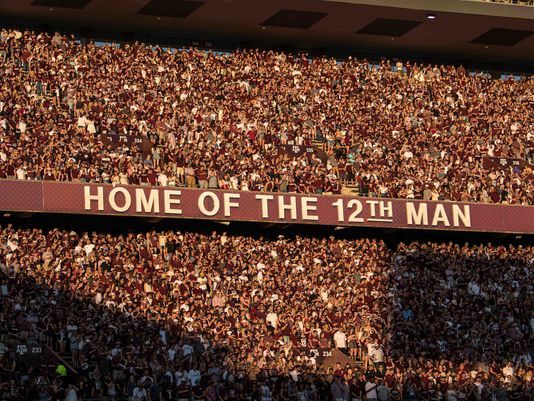The Texas A&M athletics department’s ongoing facilities upgrades again have resulted in the school rivaling the University of Texas for college sports revenue supremacy.
Texas A&M had nearly $212 million in operating revenue during its 2017 fiscal year, according to its latest financial report to the NCAA. Almost $93 million of that amount was categorized as contributions received and spent by the department during that year, the document shows.
Texas A&M’s report comes on the heels of Texas financial documents that showed the Austin campus with nearly $215 million in athletics operating revenue for 2017.
It is the first time two public universities have reported more than $200 million in athletics revenue in the same year.
But this is third consecutive year in which Texas A&M has reported annual athletics revenue of more than $190 million. Prior to these years, the school never had reached $120 million in such revenue (not adjusting for inflation).
Fundraising campaigns related to a massive redevelopment of its football stadium that began in 2014, along with several other projects, have super-charged Texas A&M’s contribution totals.
Altogether over the past three years, Texas A&M has reported a combined total of $260 million in annual contributions to athletics.
The university provided its new report to USA TODAY Sports on Monday, in response to an open-records request.
Texas A&M recently has shown its financial muscle in other ways. It fired football coach Kevin Sumlin, owing him a $10.4 million buyout. It then replaced him with Jimbo Fisher, who has been given a deal the school has placed at $75 million over 10 years.
While the report shows Texas A&M with about $147 million in operating expenses for 2017 — an apparent annual surplus of more than $65 million — it also shows the school with just under $67 million in athletics-related capital expenditures during the year.
When schools borrow money to build or refurbish athletics facilities, the NCAA currently requires them to count annual debt service payments — the amount of principal and interest they repay in a given year — as an operational expense. Cash spending on facilities is supposed to be counted, and reported, separately from annual operating expenses.
As a result, contributions to Texas A&M’s athletics program that were made in 2017 and spent on facilities projects that year are being reported as operating revenue while most of the corresponding spending on those projects is not being reported as an annual operating expense.
The Texas A&M athletics department’s chief financial officer, Jeff Toole, told USA TODAY Sports that when the facilities-related contributions are removed from consideration for 2017, “we are basically break-even, maybe a little less than break-even, for the year.”
Toole said the capital projects covered in 2017 were a continuation of the $485 million football stadium project, the construction of stadiums for softball and track and field, and the installation of some new video boards. Toole declined to provide amounts spent in 2017 on each project.
If Texas A&M’s capital spending for 2017 is added to its operational spending for the year, the total is just over $213.5 million.
Oklahoma State reported $241 million in revenue (not adjusting for inflation) for 2006, when the NCAA was having the schools use a different methodology for their annual financial reporting than the one they use now. Oklahoma State reported $211 million in donations for that year. About $165 million came from Boone Pickens, largely for facility upgrades made over time.
When Texas released its 2017 financial report a little more than a week ago, it showed nearly $215 million in annual operating revenue and $207 million in operating expenses. Texas also had nearly $4 million in capital spending, plus a separate $10.3 million transfer to the university that also is not considered an annual operating expense under the NCAA’s reporting system.
Texas A&M’s new athletics spending report showed no additional transfers to the university.
With the softball facility set to open in April and the track and field facility in September, Toole said he anticipates that Texas A&M’s revenue for its 2018 and 2019 fiscal years will resemble the 2017 total.
“After that, it might start to normalize a little bit,” Toole said, “but you never know.”


